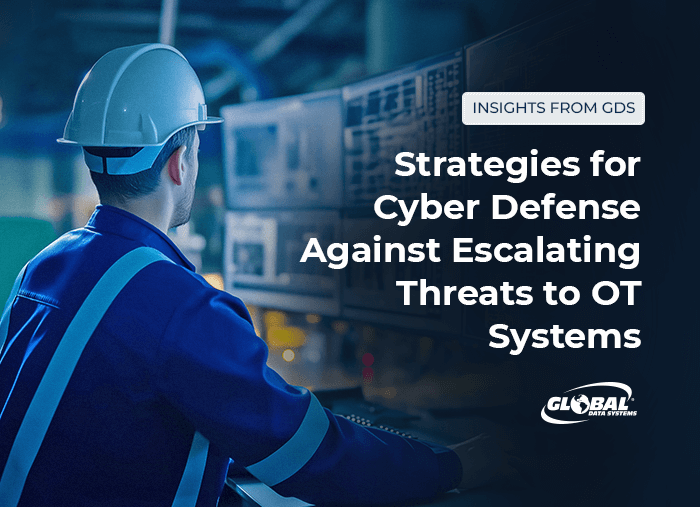Strategies for Cyber Defense Against Escalating Threats to OT Systems
The National Security Agency recently issued an urgent warning about threats to operational technology (OT) systems and critical infrastructure. Multiple federal agencies, including the Cybersecurity and Infrastructure Security Agency (CISA) and Federal Bureau of Investigation (FBI), coauthored a report highlighting the threat of pro-Russian hacktivist groups. The report provides recommendations for hardening OT systems against threat actors.

What Are OT Systems?
OT systems include industrial control systems (ICSs), supervisory control and data acquisition (SCADA) systems and human machine interfaces (HMIs). These systems support critical infrastructure in energy, utilities, transportation and aerospace, and are used in sectors such as chemicals, automotive and manufacturing, food and service, government, financial services and healthcare.
Imagine the damage that could be done if a cybercriminal took control of such components in a connected world. Service disruption for even a short period of time could threaten lives and have severe consequences for entire communities and the environment. Organizations in critical sectors need a multipronged cybersecurity defense approach to protect OT systems against attack.
The OT Security Challenge
Historically, OT components were interconnected using private-line networks. In recent years, however, public utilities have led the transition to TCP/IP networking, with OT connections increasingly moving to the public Internet. Networked OT systems are increasingly integrated with IT systems so that data can flow freely to business applications.
As OT systems become more connected to the public internet, they face increasing cyber threats. A multipronged security strategy, including 24x7 monitoring, password management, and firewalls, is essential.
These efforts are essential to the modernization of critical infrastructure but leave components and systems vulnerable. Many OT devices use weak Internet connection protocols, which opens the opportunity for attackers to conduct man-in-the-middle attacks and other exploits.
Despite the availability of security frameworks and best practices, few organizations are effectively addressing OT risks. Many are struggling to grasp the scope and gravity of the threat and are unsure how to begin incorporating effective OT security into their operational processes. IT security does not map directly to OT environments due to the unique requirements of OT systems.
Recommended Cyber Defense Measures
The report issued by NSA and other agencies notes that pro-Russia hacktivists have largely used unsophisticated measures to cause nuisances. Nevertheless, they have proven their ability to gain access to OT systems by exploiting vulnerabilities such as weak passwords and exposed Internet connections. Once inside these systems, they could create physical threats to critical infrastructure.
As a result, the security agencies recommend several commonsense steps that organizations can take to reduce the risk. Of paramount importance is changing default and weak passwords and using a strong, unique password for each system. Organizations should also implement multifactor authentication (MFA) across the OT environment.
The agencies also advise organizations to keep systems updated, disconnect all HMIs from the public Internet and upgrade end-of-life HMIs. Firewalls, VPNs and application whitelisting can also protect vulnerable OT systems. Engineering logic, network diagrams and other critical information should be backed up, and operations teams should practice running systems manually in case OT systems must be taken offline.
The Role of Managed Services
A qualified managed service provider (MSP) can help organizations in critical industries bolster the security of their OT systems. The right provider will have industry-specific expertise, providing needed skills as well as insight into emerging threats specifically targeting OT systems. The MSP will also understand the applicable regulatory requirements and best practices for OT security. The provider can perform risk and vulnerability assessments, providing an objective analysis of the organization’s security posture.
A key capability is 24x7 monitoring and incident response. Few organizations have the resources to monitor IT and OT systems around the clock. The right MSP will fill this gap, helping to identify threats quickly and ensure the continuous operation of critical systems. The MSP will also have the flexibility to scale resources up or down as business needs and operational requirements change.
Secure your OT systems with expert guidance and 24x7 protection from GDS
Contact Us >Trust GDS for OT System Cyber Defense
At GDS, we take pride in being a premier Managed Service Provider (MSP), trusted by numerous companies to safeguard their OT systems. With decades of experience, industry-leading certifications, and a commitment to delivering tailored solutions, we ensure the highest level of security and efficiency for your critical infrastructure.
GDS has a proven track record serving oil and gas, petrochemical, healthcare and other critical industries. Let us assess your environment and develop a comprehensive strategy for securing your IT and OT systems.
If you're ready to strengthen your OT systems and partner with a provider dedicated to your success, let's connect. Schedule a call with us today and discover how GDS can help protect and optimize your operations.
Benefits of Managed IT Services from Global Data Systems
- Strategic Managed IT: We help you solve your technology related business problems.
- Connectivity: We get you reliable, secure connectivity anywhere in the western hemisphere in 48 hours.
- Support: When you need help simply call our 24x7x365 support number.
- Billing: Instead of managing hundreds of vendors - get one, easy to read bill from GDS.
Contact Managed Services Provider, Global Data Systems >
